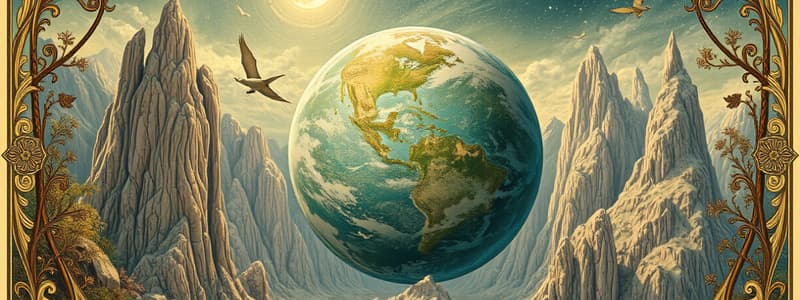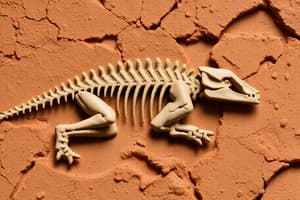Podcast
Questions and Answers
Which process is responsible for water changing from a liquid to a gas?
Which process is responsible for water changing from a liquid to a gas?
- Condensation
- Evaporation (correct)
- Infiltration (correct)
- Precipitation
What term describes the absorption of water into the ground?
What term describes the absorption of water into the ground?
- Runoff
- Condensation
- Infiltration (correct)
- Evaporation
Which of the following is a biotic component of an ecosystem?
Which of the following is a biotic component of an ecosystem?
- Sunlight
- Temperature
- Jellyfish (correct)
- Soil
What is the correct order of the levels of organization in ecology from simplest to most complex?
What is the correct order of the levels of organization in ecology from simplest to most complex?
Which level of the atmosphere is closest to the Earth's surface?
Which level of the atmosphere is closest to the Earth's surface?
What does the term ecology derive from?
What does the term ecology derive from?
Which of the following best describes the hydrologic cycle?
Which of the following best describes the hydrologic cycle?
What is precipitation in the context of the water cycle?
What is precipitation in the context of the water cycle?
Which of the following layers of the Earth is composed mainly of solid rocks and minerals?
Which of the following layers of the Earth is composed mainly of solid rocks and minerals?
In which eon did the first form of life, a unicellular organism, appear?
In which eon did the first form of life, a unicellular organism, appear?
What is the term used for the period where the Earth experienced below-zero temperatures during the Proterozoic eon?
What is the term used for the period where the Earth experienced below-zero temperatures during the Proterozoic eon?
Which process led to the formation of the Earth as specified in the Hadean eon?
Which process led to the formation of the Earth as specified in the Hadean eon?
Which landmass corresponds to modern-day countries such as North America, Europe, and Asia?
Which landmass corresponds to modern-day countries such as North America, Europe, and Asia?
What is the primary characteristic that makes Earth unique among the planets in the Solar System?
What is the primary characteristic that makes Earth unique among the planets in the Solar System?
What is the main component of the atmosphere during the Archean eon?
What is the main component of the atmosphere during the Archean eon?
Which layer of the Earth's mantle is characterized by its semi-fluid properties?
Which layer of the Earth's mantle is characterized by its semi-fluid properties?
Which relationship is characterized by one species benefiting while the other is neither helped nor harmed?
Which relationship is characterized by one species benefiting while the other is neither helped nor harmed?
What is the primary role of producers in the ecosystem?
What is the primary role of producers in the ecosystem?
What type of interaction occurs when animals compete for the same food sources?
What type of interaction occurs when animals compete for the same food sources?
What is the ultimate source of energy in the biosphere?
What is the ultimate source of energy in the biosphere?
In a predator-prey relationship, which term describes the organism that is hunted?
In a predator-prey relationship, which term describes the organism that is hunted?
What process do plants use to take in carbon dioxide during the day?
What process do plants use to take in carbon dioxide during the day?
Which of the following is NOT a type of consumer in the ecosystem?
Which of the following is NOT a type of consumer in the ecosystem?
In an ecosystem, which group of organisms can be classified as heterotrophs?
In an ecosystem, which group of organisms can be classified as heterotrophs?
Flashcards are hidden until you start studying
Study Notes
Fundamentals of the Earth and its Processes
- Earth is the only planet in the Solar System that supports life.
- It is a terrestrial planet, primarily made of rocks, and is the third planet from the sun.
- The atmosphere contains free oxygen, and liquid water covers approximately 71% of its surface, mainly in oceans.
- Earth has a diameter of about 8,000 miles (13,000 km) and is shaped like a sphere due to gravitational forces.
Earth's History
- Divided into four eons: Hadean, Archean, Proterozoic, and Phanerozoic, each marked by significant geological and biological developments.
Hadean (4,540-4,000 Million Years Ago)
- Formed from cosmic debris, with no life and extreme temperatures.
- Characterized by frequent volcanic eruptions and a nebular atmosphere.
Archean (4,000-2,500 Million Years Ago)
- Marked by the emergence of prokaryotic unicellular life.
- Presence of some landmasses and an atmosphere rich in greenhouse gases.
Proterozoic (2,500-541 Million Years Ago)
- Known as "early life," featuring the rise of eukaryotic multicellular organisms.
- Experienced periods known as "Snow Ball Earth" when global temperatures dropped significantly.
Phanerozoic (541 Million Years Ago - Present)
- Characterized by complex life forms and the existence of modern oceans.
- Evolution of modern plants, animals, and humans occurred, along with the formation and separation of the supercontinent Pangaea.
Pangaea, Laurasia, and Gondwanaland
- Pangaea: A supercontinent that included nearly all of Earth's landmasses.
- Laurasia: Composed of current areas like North America, Europe, and Asia.
- Gondwanaland: Included the landmasses of Africa, South America, Australia, Antarctica, and the Indian subcontinent.
Layers of the Earth
- Crust: The outermost layer composed of solid rocks and minerals.
- Mantle: The thick, mostly solid layer beneath the crust, divided into five parts: Lithosphere, Asthenosphere, Transition Zone, Lower Mantle, and D" (D Prime).
- Core: The innermost layer, extremely hot and dense, primarily made of iron and nickel.
Hydrosphere and Water Cycle
- The hydrosphere encompasses all water on, under, and above Earth's surface.
- The water cycle involves continuous movement of water through:
- Evaporation: Liquid water changes to gas.
- Condensation: Water vapor becomes liquid.
- Precipitation: Water falls back to Earth in liquid or frozen form.
- Infiltration: Water absorbs into the ground.
- Runoff: Water that flows over the ground surface into water bodies.
Atmosphere Layers
- Troposphere
- Stratosphere
- Mesosphere
- Thermosphere
- Exosphere
Ecology Basics
- Focuses on interactions between organisms and their environment, emerging from Greek words meaning 'household' and 'study.'
- Ecologists study ecosystems across land and water environments.
Biotic and Abiotic Components
- Biotic: Living components, including plants, animals, bacteria.
- Abiotic: Non-living factors, including sunlight, soil, temperature.
Levels of Organization in Ecology
- Organism: An individual living entity.
- Population: A group of the same species in an area.
- Community: Multiple species populations in a region.
- Ecosystem: Interaction of biotic and abiotic elements.
- Biosphere: Contains all ecosystems, supporting life.
Habitat and Niche
- Habitat: The physical environment where a population lives.
- Niche: The role and resources required for a species' survival, growth, and reproduction.
Interspecific Interactions
- Competition: Organisms competing for resources.
- Predation: One organism kills and consumes another (predator-prey dynamics).
- Symbiosis: Long-term interactions between species, with types including:
- Mutualism: Both species benefit.
- Commensalism: One benefits, other is neither helped nor harmed.
- Parasitism: One benefits at the expense of another.
Energy Flow in Ecosystems
- The sun is the ultimate energy source for the biosphere.
- Plants convert light energy through photosynthesis, while consumers derive energy by eating other organisms.
Major Roles of Organisms in Ecosystems
- Producers (Autotrophs): Create organic molecules from inorganic substances using photosynthesis or chemosynthesis.
- Consumers (Heterotrophs): Obtain energy by consuming other organisms; include herbivores, carnivores, omnivores, and scavengers.
Plants Trivia
- During the day, plants absorb carbon dioxide and release oxygen.
- At night, they take in oxygen and expel carbon dioxide.
Studying That Suits You
Use AI to generate personalized quizzes and flashcards to suit your learning preferences.




